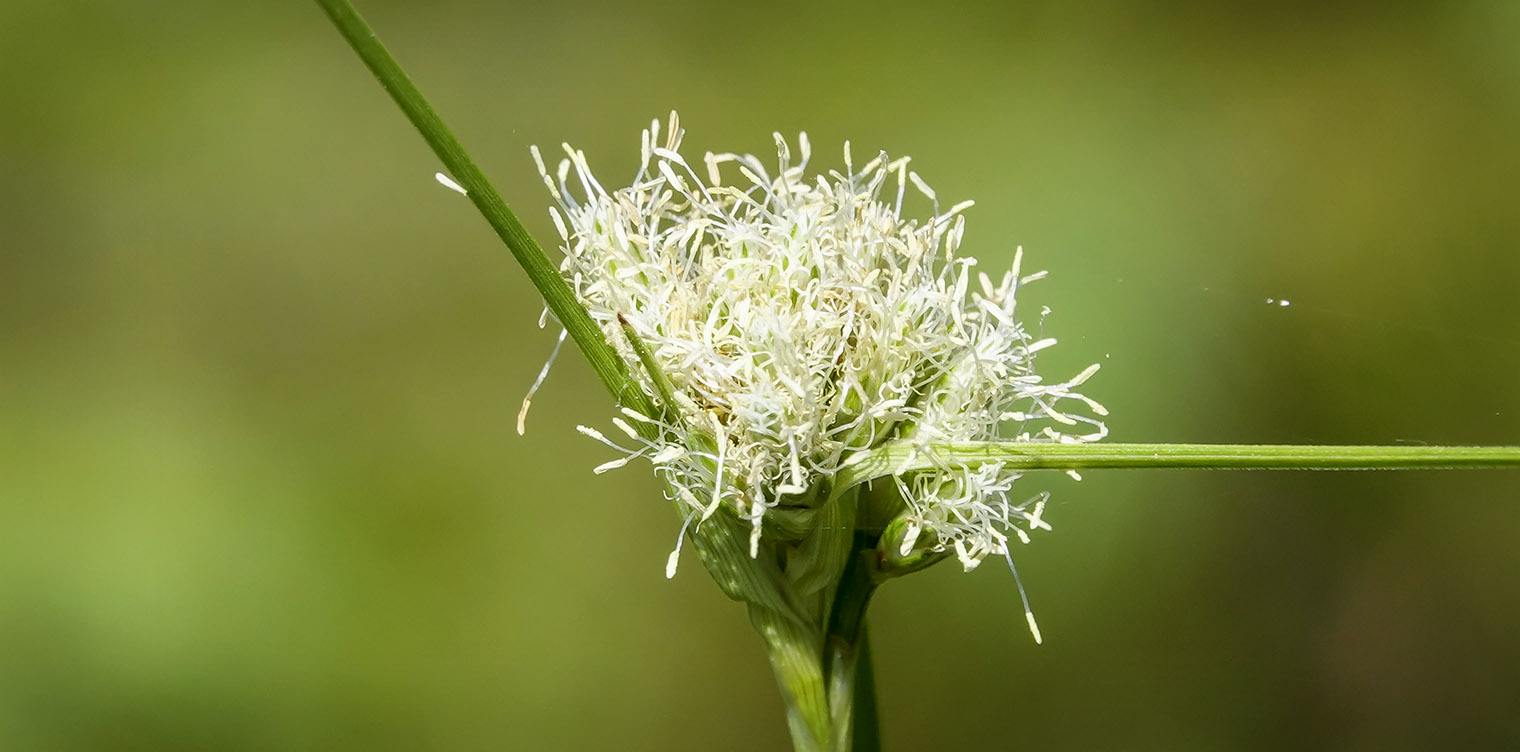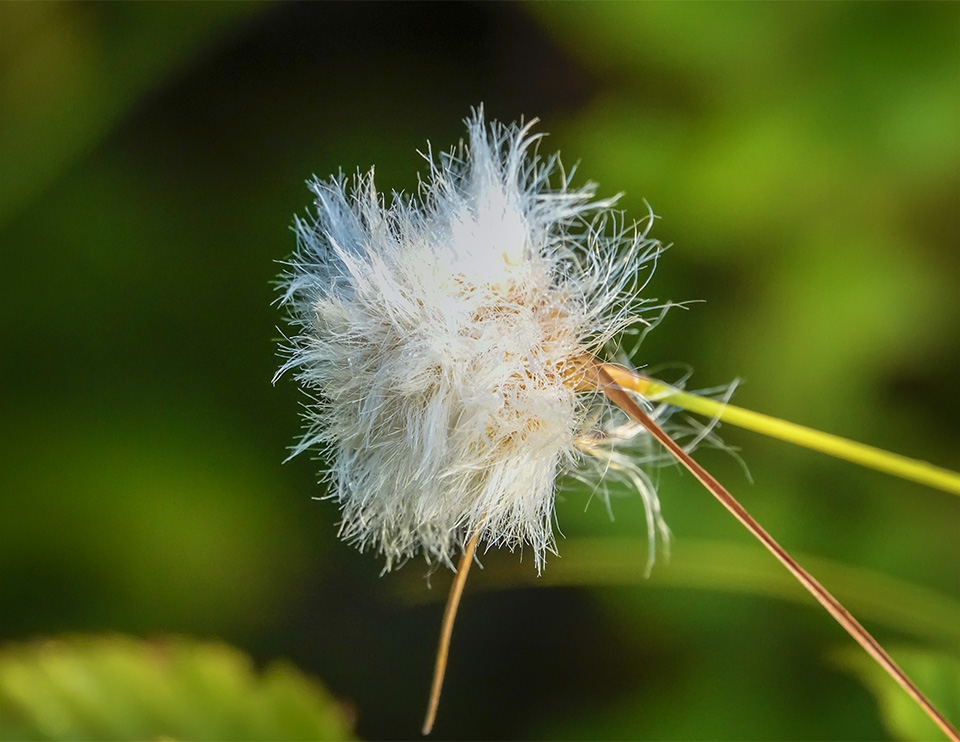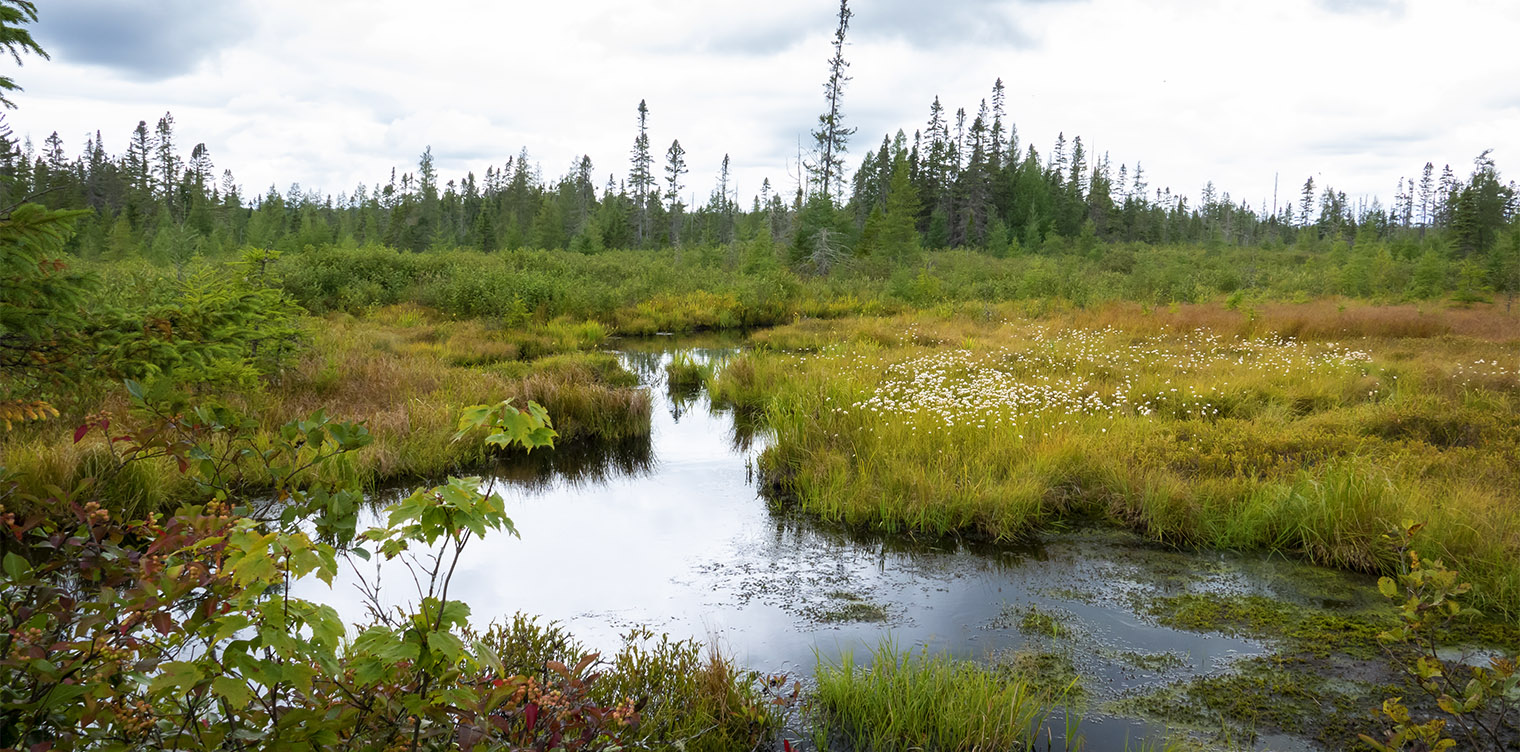Wildflowers of the Adirondacks:
Cottongrass (Eriophorum spp.)

Cottongrass (Eriophorum spp.) is a sedge which produces white or tawny tufts and grows in wetlands in the Adirondack Mountains of upstate New York.
Five species of Cottongrass occur in the Adirondack Park:
- Tawny Cotton-grass (Eriophorum virginicum)
- Tussock Cottongrass (Eriophorum vaginatum)
- Green Keeled Cottongrass (Eriophorum viridicarinatum)
- Rough Cotton-grass (Eriophorum tenellum)
- Slender Cotton-grass (Eriophorum gracile)
The common name is a reference to the cottony nature of the fruiting head. The scientific name Eriophorum derives from the Greek words erion (cotton or wool) and phoros (bearing).
Identification of Cottongrass

Cottongrasses are not true grasses, but sedges. In contrast to grasses, which have hollow stems, the stems of most sedges are solid and triangular, giving rise to the mnemonic device: "sedges have edges." Cottongrass has slender, grass-like leaves. The seed heads are covered with a cottony mass, which gives Cottongrass its name.
- Tussock Cottongrass (also called Rusty Cotton-grass) has a tuft of white cottony bristles at the tip of a stem with greatly reduced leaves. The cottony heads can be seen in early June and July in the Adirondacks.
- Tawny Cotton-grass (also called Hare's Tail) has bristles which are typically copper-colored to tan. This species fruits from mid-summer to early fall.
- Slender Cotton-grass (also called Slender Cottonsedge) is topped by a cluster of white, bristly inflorescences which look like tufts of wool when seen from a distance. It fruits from late spring to mid-summer.
- Rough Cotton-grass (also called Fewnerved Cottongrass) has a small, white, cottony spikelet. It fruits in summer.
- Green Keeled Cottongrass (also called Thinleaf Cottonsedge) has white or pale brown bristles and fruits in summer.
Uses of Cottongrass
Cottongrass has few uses. One source suggests that the young stem bases and roots of Slender Cotton-grass can be eaten raw or cooked. The cottony seeds hairs have been used to make candle wicks and for stuffing pillows. There are no known medicinal uses.
Wildlife Value of Cottongrass
This species has limited wildlife value in our region. Sedges, including Cottongrass, provides the caterpillar host for the Jutta Arctic butterfly. A number of bird species breed in habitats where Cottongrass occurs. However, all of these species breed in the far north, in northern Canada or Alaska. In these areas, Tussock Cottongrass is a common food item for grazing herbivores such as elk, deer, caribou, reindeer. It is also consumed by grizzly bears, ptarmigan, and geese.
Distribution of Cottongrass
The range of Cottongrass depends on the species.
- Tawny Cotton-grass grows in the northeastern part of the US, south to Georgia and west to Wisconsin and Minnesota. This species is present in nearly all New York State counties in the middle and eastern part of the state, including all counties within the Adirondack Park Blue Line, with the exception of Clinton County.
- Tussock Cottongrass occurs from Alaska south to British Columbia, east to New England, and north to Greenland. In New York State, it occurs in most counties in the eastern part of the state. This species can be found in all Adirondack Park Blue line counties, except Clinton, Fulton, and Saratoga.
- Slender Cotton-grass occurs in the northern part of the US and throughout Canada and Alaska. This species is found in a number of counties in central New York State, including several on the margins of the Adirondack Park.
- Rough Cotton-grass occurs in northeastern United States and the eastern provinces of Canada. In New York State, it is found in almost all counties in the eastern part of the state, including all counties within the Adirondack Park Blue Line, except Warren County.
- Green Keeled Cottongrass occurs in the northern part of the US, as well as the southern Canadian provinces and Alaska. In New York State, this species has been documented in many counties in the eastern part of the state. It is found in all counties within the Adirondack Park Blue Line except Clinton and Franklin counties.
Habitat of Cottongrass

Cottongrass typically occurs in peaty wetlands, such as acidic bogs and poor fens. In the Adirondacks, Cottongrass is found in several ecological communities:
The most convenient places to observe Cottongrass include Barnum Bog at the Paul Smiths VIC and Bloomingdale Bog.
- Look for Cottongrass blooming near stunted Tamaracks and Black Spruce, with bog-dwelling shrubs such as Labrador Tea, Bog Laurel, Sheep Laurel, and Bog Rosemary.
- Wildflowers that bloom in this habitat include Buckbean, Rose Pogonia, Pitcher Plant, and Grass Pink.
- Characteristic birds include Lincoln's Sparrow, Palm Warbler, and Yellow-bellied Flycatcher.
In the Adirondack Mountains, you can also find Cottongrass in higher elevation alpine zones, near the summits of mountains in the High Peaks region, including Marcy, Algonquin, Wright, Iroquois, Coldin, Haystack, Basin, Saddleback, Gothics, Dix, and Whiteface.
References
Michael Kudish. Adirondack Upland Flora: An Ecological Perspective (The Chauncy Press, 1992), pp. 220-221.
New York Flora Association. New York Flora Atlas. Eriophorum gracile. Retrieved 22 March 2017.
New York Flora Association. New York Flora Atlas. Eriophorum tenellum. Retrieved 22 March 2017.
New York Flora Association. New York Flora Atlas. Eriophorum vaginatum. Retrieved 22 March 2017.
New York Flora Association. New York Flora Atlas. Eriophorum virginicum. Retrieved 22 March 2017.
New York Flora Association. New York Flora Atlas. Eriophorum viridicarinatum. Retrieved 22 March 2017.
United States Department of Agriculture. The Plants Database. Slender Cottongrass. Eriophorum gracile W.D.J. Koch. Retrieved 22 March 2017.
United States Department of Agriculture. The Plants Database. Fewnerved Cottongrass. Eriophorum tenellum Nutt. Retrieved 23 March 2017.
United States Department of Agriculture. The Plants Database. Tussock Cottongrass. Eriophorum vaginatum L. Retrieved 22 March 2017.
United States Department of Agriculture. The Plants Database. Tawny Cottongrass. Eriophorum virginicum L. Retrieved 23 March 2017.
United States Department of Agriculture. The Plants Database. Thinleaf Cottonsedge. Eriophorum viridicarinatum (Engelm.) Fernald. Retrieved 23 March 2017.
United States Department of Agriculture. Fire Effects Information System (FEIS). Species Reviews. Eriophorum vaginatum. Retrieved 23 March 2017.
United States Department of Agriculture. Fire Effects Information System (FEIS). Species Reviews. Eriophorum viridicarinatum. Retrieved 23 March 2017.
Flora of North America. Eriophorum gracile. Retrieved 23 March 2017.
Flora of North America. Eriophorum tenellum Nuttall. Retrieved 23 March 2017.
Flora of North America. Eriophorum vaginatum. Retrieved 23 March 2017.
Flora of North America. Eriophorum virginicum Linnaeus. Retrieved 23 March 2017.
Flora of North America. Eriophorum viridicarinatum (Engelmann) Fernald. Retrieved 22 March 2017.
Northern Forest Atlas. Images. Eriophorum. Retrieved 23 March 2017.
New York State. Department of Environmental Conservation. New York Natural Heritage Program. Ecological Communities of New York State. Second Edition (March 2014), pp 57-58, 58-59, 60-61, 63-64, 64, 76, 92-93. Retrieved 17 October 2015.
New York Natural Heritage Program. 2019. Online Conservation Guide for Black Spruce-Tamarack Bog. Retrieved 13 November 2019.
New York Natural Heritage Program. 2019. Online Conservation Guide for Dwarf Shrub Bog. Retrieved 13 November 2019.
New York Natural Heritage Program. 2019. Online Conservation Guide for Inland Poor Fen. Retrieved 13 November 2019.
New York Natural Heritage Program. 2019. Online Conservation Guide for Open Alpine Community. Retrieved 13 November 2019.
New York Natural Heritage Program. 2019. Online Conservation Guide for Patterned Peatland. Retrieved 13 November 2019.
New York Natural Heritage Program. 2019. Online Conservation Guide for Rich Graminoid Fen. Retrieved 13 November 2019.
New York Natural Heritage Program. 2019. Online Conservation Guide for Rich Sloping Fen. Retrieved 13 November 2019.
New York State. Adirondack Park Agency. Preliminary List of Species Native Within the Adirondack Park Listed Alphabetically by Scientific Name and Sorted by Habit. Volume 1. Updated 10.23.2006, p. 52. Retrieved 26 January 2017.
University of Wisconsin. Flora of Wisconsin. Eriophorum virginicum L. Retrieved 23 March 2017.
Lady Bird Johnson Wildflower Center. Tawny Cottongrass. Eriophorum virginicum L. Retrieved 23 March 2017.
Lady Bird Johnson Wildflower Center. Eriophorum vaginatum. Retrieved 23 March 2017.
Ronald B. Davis. Bogs & Fens. A Guide to the Peatland Plants of the Northeastern United States and Adjacent Canada (University Press of New England, 2016), pp. 158-163.
Doug Ladd. North Woods Wildflowers (Falcon Publishing, 2001), p. 180.
Donald D. Cox. A Naturalist's Guide to Wetland Plants. An Ecology for Eastern North America (Syracuse University Press, 2002), p. 91.
John Eastman. The Book of Swamp and Bog: Trees, Shrubs, and Wildflowers of Eastern Freshwater Wetlands (Stackpole Books, 1995), pp. 57-59.
Plants for a Future. Eriophorum gracile - Roth. Retrieved 23 March 2017.
University of Michigan. Native American Ethnobotany. A Database of Foods, Drugs, Dyes and Fibers of Native American Peoples, Derived from Plants. Eriophorum. Retrieved 22 March 2017.
Butterflies and Moths of North America. Jutta Arctic. Retrieved 24 March 2017.
Nancy G. Slack and Allison W. Bell. Adirondack Alpine Summits: An Ecological Field Guide (Adirondack Mountain Club, Inc., 2006), p. 53.
